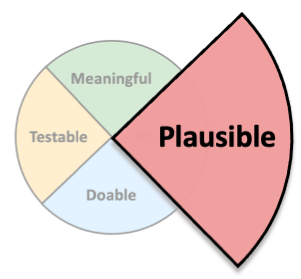Home » Enhancing Program Performance with Logic Models » Section 6: How Good is My Logic Model? » 6.3: Criteria 2 – Plausible
6.3: Criteria 2 – Plausible

Plausible: The logic model makes sense
- Is there research, experience, or evidence to suggest that the activities will reach/engage the intended participants? Will they lead to the short-term outcomes? And are they, in turn, connected to the intermediate and long-term outcomes?
- Is the model truly logical? Do the relationships among the program elements make sense? Are there any missing steps or gaps in logic? Are all the casual relationships supported?
- Is each listed outcome truly an “outcome”? Does the logic model clearly separate outcomes from outputs? Are all important outcomes included?
Three Ways to Check Whether or Not it is Plausible
- Starting at inputs, at each level ask, “Why?”: Why do we need these inputs? Why do we need to conduct these activities?
- Starting at the long-term outcome and working backward, you should find the answer to “How?” in the immediately preceding information. The question “How are we going to produce these outcomes?” should be answered by looking at the immediately preceding items.
- Sometimes components are necessary but not sufficient. Ask yourself, “What else?” For example, achieving healthy one-year-old babies requires not only achieving a healthy birth but also achieving proper care during the baby’s first year. Asking ‘”What else?” helps spot gaps in logic.
What about your assumptions? For every planned action and linkage in the logic model, identify and ask yourself, “Why do I think this is true?”
What about external factors?




